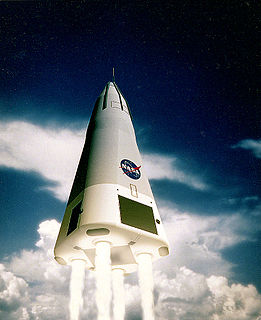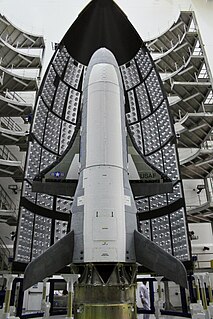
A reusable launch system is a launch system that includes the recovery of some or all of the component stages. To date, several fully reusable suborbital systems and partially reusable orbital systems have been flown.

The Lockheed Martin X-33 was an uncrewed, sub-scale technology demonstrator suborbital spaceplane developed in the 1990s under the U.S. government–funded Space Launch Initiative program. The X-33 was a technology demonstrator for the VentureStar orbital spaceplane, which was planned to be a next-generation, commercially operated reusable launch vehicle. The X-33 would flight-test a range of technologies that NASA believed it needed for single-stage-to-orbit reusable launch vehicles, such as metallic thermal protection systems, composite cryogenic fuel tanks for liquid hydrogen, the aerospike engine, autonomous (uncrewed) flight control, rapid flight turn-around times through streamlined operations, and its lifting body aerodynamics.

The DC-X, short for Delta Clipper or Delta Clipper Experimental, was an uncrewed prototype of a reusable single-stage-to-orbit launch vehicle built by McDonnell Douglas in conjunction with the United States Department of Defense's Strategic Defense Initiative Organization (SDIO) from 1991 to 1993. Starting 1994 until 1995, testing continued through funding of the US civil space agency NASA. In 1996, the DC-X technology was completely transferred to NASA, which upgraded the design for improved performance to create the DC-XA.

The Boeing X-37, also known as the Orbital Test Vehicle (OTV), is a reusable robotic spacecraft. It is boosted into space by a launch vehicle, then re-enters Earth's atmosphere and lands as a spaceplane. The X-37 is operated by the United States Space Force, and was previously operated by Air Force Space Command until 2019 for orbital spaceflight missions intended to demonstrate reusable space technologies. It is a 120-percent-scaled derivative of the earlier Boeing X-40. The X-37 began as a NASA project in 1999, before being transferred to the United States Department of Defense in 2004.

The Dream Chaser is an American reusable lifting-body spaceplane being developed by Sierra Nevada Corporation (SNC) Space Systems. Originally intended as a crewed vehicle, the Dream Chaser Space System, to be produced after the cargo variant, Dream Chaser Cargo System, is operational. The crewed variant is capable of carrying up to seven people and cargo to and from low Earth orbit.

Philip Bono was a Douglas Aircraft Company engineer. He was a pioneer of reusable vertical landing single-stage to orbit launch vehicles. As a visionary designer, he is credited with inventing the first version of a recoverable single-stage spacecraft booster, and his contributions influenced spacecraft design.

Daniel O. Graham was a U.S. Army officer. Graham was born in Portland, Oregon and grew up in Medford. He attended college at the United States Military Academy at West Point, the army's Command and General Staff College, and graduated in 1946. He also attended the U.S. Army War College and ultimately rose to the rank of lieutenant general in the United States Army. Graham served in Germany, Korea, and Vietnam and received several decorations including some of the highest the United States military bestows: the Distinguished Service Medal, the Legion of Merit with two oak leaf clusters, and the Distinguished Intelligence Medal during his distinguished 30-year military career.

The Common Booster Core (CBC) is an American rocket stage, which is used on the Delta IV rocket as part of a modular rocket system. Delta IV rockets flying in the retired Medium and Medium+ configurations each used a single Common Booster Core as their first stage, while the Heavy configuration uses three; one as the first stage and two as boosters. The Common Booster Core is 40.8 metres (134 ft) long, has a diameter of 5.1 metres (17 ft) and is powered by a single RS-68 engine burning liquid hydrogen and liquid oxygen.
Maxwell White Hunter II was a prominent American aerospace engineer. He worked on the design of the Douglas B-42 and Douglas B-43 bombers, the Honest John, Nike-Ajax, and Nike-Zeus missiles, the Thor IRBM, and on parts of the Strategic Defense Initiative. In later years he worked on space-launch vehicles and was a proponent of Single-stage-to-orbit (SSTO) designs. He was honored in 1995 by the National Space Society for lifelong contributions to the technology of spaceflight.

New Shepard is a vertical-takeoff, vertical-landing (VTVL), crew-rated suborbital launch vehicle that is being developed by Blue Origin as a commercial system for suborbital space tourism. Blue Origin is owned and led by Amazon.com founder and businessman Jeff Bezos and aerospace engineer Rob Meyerson. NASA Silver Snoopy Award winner Robert Smith is the company's chief executive officer.

Vertical takeoff, vertical landing (VTVL) is a form of takeoff and landing for rockets. Multiple VTVL craft have flown. The most widely known and commercially successful VTVL rocket is SpaceX's Falcon 9 first stage.
This is the comparison of orbital launch systems page. It contains two lists of conventional orbital launch systems, separated by operational status. For the simple list of all conventional launcher families, see: Comparison of orbital launchers families. For the list of predominantly solid-fueled orbital launch systems, see: Comparison of solid-fueled orbital launch systems.

The Space Launch System (SLS) is a super heavy-lift expendable launch vehicle, which has been under development by NASA in the United States since its announcement in 2011. It will be the primary launch vehicle of NASA's deep space exploration plans, including the planned crewed lunar flights of the Artemis program and a possible follow-on human mission to Mars. The SLS program has replaced the Constellation program's Ares V launch vehicle program of 2005, which never left the development phase. SLS is intended to replace the retired Space Shuttle as NASA's flagship vehicle. Following the cancellation of the Constellation program, the NASA Authorization Act of 2010 envisioned a single launch vehicle usable for both crew and cargo. In 2013, SLS was projected to possibly be the most capable super-heavy lift vehicle ever built.

The Falcon Heavy is a partially reusable heavy-lift launch vehicle designed and manufactured by SpaceX. It is derived from the Falcon 9 vehicle and consists of a strengthened Falcon 9 first stage as the center core with two additional Falcon 9-like first stages as strap-on boosters. The Falcon Heavy has the highest payload capacity of any currently operational launch vehicle, and the third-highest capacity of any rocket ever to reach orbit, trailing the Saturn V and Energia.

Orion is a class of partially reusable space capsules to be used in NASA's human spaceflight programs. The spacecraft consists of a Crew Module (CM) manufactured by Lockheed Martin and the European Service Module (ESM) manufactured by Airbus Defence and Space. Capable of supporting a crew of six beyond low Earth orbit, Orion can last up to 21 days undocked and up to six months docked. It is equipped with solar panels, an automated docking system, and glass cockpit interfaces modeled after those used in the Boeing 787 Dreamliner. A single AJ10 engine provides the spacecraft's primary propulsion, while eight R-4D-11 engines, and six pods of custom reaction control system engines developed by Airbus, provide the spacecraft's secondary propulsion. Although compatible with other launch vehicles, Orion is primarily designed to launch atop a Space Launch System (SLS) rocket, with a tower launch escape system.

Aerojet Rocketdyne is an American rocket and missile propulsion manufacturer. Headquartered in Sacramento, California, the company is owned by Aerojet Rocketdyne Holdings. Aerojet Rocketdyne was formed in 2013 when Aerojet and Pratt & Whitney Rocketdyne were merged, following the latter's acquisition by GenCorp from Pratt & Whitney. On April 27, 2015, the name of the holding company, GenCorp, was changed from GenCorp, Inc. to Aerojet Rocketdyne Holdings, Inc. As part of an acquisition move, Lockheed Martin will be taking over Aerojet Rocketdyne in the second half of 2021. The deal was struck for $4.4 Billion on December 20, 2020.

A super heavy-lift launch vehicle (SHLLV) is a launch vehicle capable of lifting more than 50 tonnes (110,000 lb) of payload into low Earth orbit (LEO).

The SpaceX Starship system is a fully-reusable, two-stage-to-orbit, super heavy-lift launch vehicle under development by SpaceX since 2012, as a self-funded private spaceflight project.















